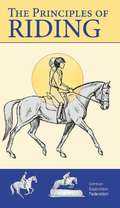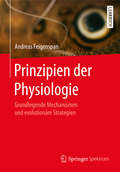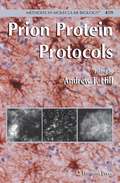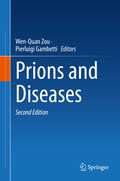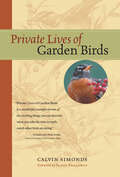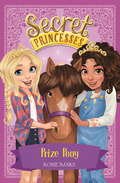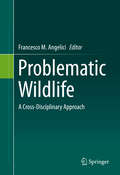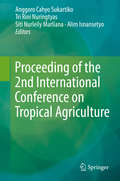- Table View
- List View
The Principles of Riding: Basic Training for Horse and Rider
by German National Equestrian FederationThe first edition of The Principles of Riding was published more than 50 years ago, imparting mandatory basic knowledge for all areas of equestrian sport and horse-keeping and this 28th edition, Basic Training for Horse and Rider, has been completely revised regarding language and content, while still taking into account the well-established principles. The consideration of traditional principles leads to the education and training of the horse according to its nature and thus to its health, well-being and performance capability.The horse s instincts and natural behaviour are presented in detail as the basis of communication and understanding between horse and rider. Modern scientific research relating to training theory and biomechanics has influenced the systematic training of the rider as well as that of the horse. The Principles of Riding provides versatile, practical assistance to horse lovers and readers of this book who want to learn, irrespective of whether they ride for leisure or competitively, are interested in hacking or hunting, or want to develop and improve their basic training for dressage, show-jumping or eventing.These Principles should be indispensable for all riders, drivers, trainers and judges, and to all of those who are interested in the appropriate training of the horse, according to the horse s nature, and who place importance on a harmonious cooperation between horse and rider.
Principles of Statistical Genomics
by Shizhong XuStatistical genomics is a rapidly developing field, with more and more people involved in this area. However, a lack of synthetic reference books and textbooks in statistical genomics has become a major hurdle on the development of the field. Although many books have been published recently in bioinformatics, most of them emphasize DNA sequence analysis under a deterministic approach. Principles of Statistical Genomics synthesizes the state-of-the-art statistical methodologies (stochastic approaches) applied to genome study. It facilitates understanding of the statistical models and methods behind the major bioinformatics software packages, which will help researchers choose the optimal algorithm to analyze their data and better interpret the results of their analyses. Understanding existing statistical models and algorithms assists researchers to develop improved statistical methods to extract maximum information from their data. Resourceful and easy to use, Principles of Statistical Genomics is a comprehensive reference for researchers and graduate students studying statistical genomics.
Principles of Veterinary Parasitology
by Dennis Jacobs Mark Fox Lynda Gibbons Carlos HermosillaPrinciples of Veterinary Parasitology is a student-friendly introduction to veterinary parasitology. Written primarily to meet the immediate needs of veterinary students, this textbook outlines the essential parasitological knowledge needed to underpin clinical practice. Conceptual relationships between parasitic organisms, their biology and the diseases they cause are clearly illustrated. Help boxes and practical tips are included throughout alongside a wealth of colour photographs, drawings and life-cycle diagrams. Organised taxonomically with additional host-orientated chapters and focussing on parasites that commonly cause animal or zoonotic disease, welfare problems or economic losses, students worldwide will benefit from this straightforward and easy to comprehend introduction to veterinary parasitology. Key features include: An easy to navigate textbook, providing information essential for clinical studies Full colour throughout, with photographs, diagrams, life-cycles and help boxes for visual learners A companion website including a pronunciation guide, self-assessment questions and further reading lists
Principles of Veterinary Parasitology
by Dennis Jacobs Mark Fox Lynda Gibbons Carlos HermosillaPrinciples of Veterinary Parasitology is a student-friendly introduction to veterinary parasitology. Written primarily to meet the immediate needs of veterinary students, this textbook outlines the essential parasitological knowledge needed to underpin clinical practice. Conceptual relationships between parasitic organisms, their biology and the diseases they cause are clearly illustrated. Help boxes and practical tips are included throughout alongside a wealth of colour photographs, drawings and life-cycle diagrams. Organised taxonomically with additional host-orientated chapters and focussing on parasites that commonly cause animal or zoonotic disease, welfare problems or economic losses, students worldwide will benefit from this straightforward and easy to comprehend introduction to veterinary parasitology. Key features include: An easy to navigate textbook, providing information essential for clinical studies Full colour throughout, with photographs, diagrams, life-cycles and help boxes for visual learners A companion website including a pronunciation guide, self-assessment questions and further reading lists
Principles of Wildlife Conservation
by Ankur AwadhiyaWildlife tend our forests — they pollinate flowers, disperse seeds, eat insects that harm trees, and keep herbivores and diseases in check. They keep our forests healthy and resilient — ready and able to face and counter any challenges — such as global warming and climate change. They are the individual cogs that keep the forest machine functioning. And we desperately need our forests — to sequester carbon, to purify our air and water, to protect our soils from getting eroded, and to save our dams and waterways. Wildlife do need our care, concern and attention, but we also need our wildlife — perhaps much more sincerely. A majority of wildlife arrived on this planet much before humans, and the Earth belongs to them as well. So how do we conserve wildlife? This is the question that Principles of Wildlife Conservation seeks to answer. It presents a lucid — cogent yet simple narration about the why's and how's of conserving wildlife. It begins with the first principles — and thus requires no more prerequisite than an urge to seek knowledge. It is full of pictures and case studies from the field — to facilitate easy grasping of the subject. The book builds a solid foundation of the theory of wildlife conservation, and tops that up with experiences from actually doing wildlife conservation. In this way, it equips the reader to master both the science, and the art, of conserving wildlife.
Principles of Wildlife Conservation
by Ankur AwadhiyaWildlife tend our forests — they pollinate flowers, disperse seeds, eat insects that harm trees, and keep herbivores and diseases in check. They keep our forests healthy and resilient — ready and able to face and counter any challenges — such as global warming and climate change. They are the individual cogs that keep the forest machine functioning. And we desperately need our forests — to sequester carbon, to purify our air and water, to protect our soils from getting eroded, and to save our dams and waterways. Wildlife do need our care, concern and attention, but we also need our wildlife — perhaps much more sincerely. A majority of wildlife arrived on this planet much before humans, and the Earth belongs to them as well. So how do we conserve wildlife? This is the question that Principles of Wildlife Conservation seeks to answer. It presents a lucid — cogent yet simple narration about the why's and how's of conserving wildlife. It begins with the first principles — and thus requires no more prerequisite than an urge to seek knowledge. It is full of pictures and case studies from the field — to facilitate easy grasping of the subject. The book builds a solid foundation of the theory of wildlife conservation, and tops that up with experiences from actually doing wildlife conservation. In this way, it equips the reader to master both the science, and the art, of conserving wildlife.
Prinzipien der Physiologie: Grundlegende Mechanismen und evolutionäre Strategien
by Andreas FeigenspanDieses Lehrbuch entwickelt grundlegende Konzepte der Physiologie, indem es jeweils von einer Fragestellung, einem zu lösenden Problem ausgeht und verschiedene Lösungsstrategien erörtert. Konkrete Beispiele veranschaulichen den untrennbaren Zusammenhang von Struktur und Funktion und schaffen so die Voraussetzungen für ein vertieftes Verständnis physiologischer Prozesse sowie eine Wertschätzung biologischer Vielfalt, die in dem ihr zur Verfügung stehenden Raum häufig bis an die äußersten Grenzen geht. Tierische Organismen sind Meisterwerke der Evolution, in zahllosen Generationen zur Erfüllung grundlegender Aufgaben optimiert: effiziente Aufnahme und Verteilung von Nährstoffen und Atemgasen, Synthese komplexer Makromoleküle, reibungslose Koordination von Bewegungen und schnelle, präzise Verarbeitung von Informationen. Physikalische und chemische Gesetzmäßigkeiten markieren die Grenzen und legen den Möglichkeitsraum fest, in dem erstaunliche und faszinierende Lösungen für diese Aufgaben entstanden sind.
Prion Protein Protocols (Methods in Molecular Biology #459)
by Andrew F. HillWhile much information has been gained regarding the molecular nature of prion proteins, only recently have several research groups begun to cast light on turning the normal prion protein into its aberrant, infectious form. In this book, a team of experts provide the most up-to-date collection of current methods in this unique area of neuroscience. Comprehensive and cutting-edge, this is an ideal collection for researchers investigating the growing field of mammalian prion disease.
Prions and Diseases: Volume 1, Physiology and Pathophysiology
by Wen-Quan Zou and Pierluigi GambettiVolume I highlights the association of the cellular prion protein (PrPC) with copper and zinc, the potential roles of PrPC in Alzheimer’s disease and cancers, insoluble PrPC, PMCA, molecular and cellular mechanisms of PrPSc formation and clearance, possible co-factors involved in the conversion of PrPC into PrPSc, infectious and pathogenic forms of PrP, cell biology of prions, prion strains and their interference, as well as yeast prions and their inheritable and structural traits. This unique volume will take you through the fascinating chronicle of prions in mammals, yeast, and fungi.
Prions and Diseases: Volume 2, Animals, Humans and the Environment
by Wen-Quan Zou and Pierluigi GambettiVolume II features a variety of animal and human prion diseases, including the newly-identified atypical forms of bovine spongiform encephalopathy and scrapie in animals, and variably protease-sensitive prionopathy in humans, prions in the environment, Tau pathology in human prion disease, transmission of the disease by blood transfusion, mammalian and non-mammalian models, conventional and advanced diagnoses, prion-specific antibodies, as well as decontamination of prions and development of therapeutics of prion diseases, such as the application of immunomodulation. This volume provides up-to-date knowledge about the etiology, pathogenesis, classification, histopathological, and clinical aspects of the highly publicized animal and human prion diseases.
Prions and Diseases
by Wen-Quan Zou Pierluigi GambettiTransmissible spongiform encephalopathies (TSE), known as prion diseases, have been recognized for nearly 300 years in animals and almost 100 years in humans. Modern studies, including the protein-misfolding cyclic amplification (PMCA), have greatly advanced our understanding of the pathogenesis of prion diseases and facilitated the identification of new prion diseases in animals and humans. In the second edition of Prions and Diseases, more than 60 leading researchers and clinicians worldwide provide an up-to-date discussion of these unique infectious pathogens and their associated diseases. The book provides up-to-date knowledge about the etiology, pathogenesis, classification, histopathological, and clinical aspects of the full range of animal and human prion diseases. As a result, the book contains by far the most authoritative views about the past, present, and future of prions and prion diseases. The new second edition covers such important emerging topics such as inherited human prion disease, stem-cell models in prion research, human prion disease surveillance, and gene therapy strategies.
Prison Dog Programs: Renewal and Rehabilitation in Correctional Facilities
by Mary Renck JalongoThis edited volume brings together a diverse group of contributors to create a review of research and an agenda for the future of dog care and training in correctional facilities. Bolstered by research that documents the potential benefits of HAI, many correctional facilities have implemented prison dog programs that involve inmates in the care and training of canines, not only as family dogs but also as service dogs for people with psychological and/or physical disabilities. Providing an evidence-based treatment of the topic, this book also draws upon the vast practical experience of individuals who have successfully begun, maintained, improved, and evaluated various types of dog programs with inmates; it includes first-person perspectives from all of the stakeholders in a prison dog program—the corrections staff, the recipients of the dogs, the inmate/trainers, and the community volunteers and sponsors Human-animal interaction (HAI) is a burgeoning field of research that spans different disciplines: corrections, psychology, education, social work, animal welfare, and veterinary medicine, to name a few. Written for an array of professionals interested in prison dog programs, the book will hold special interest for researchers in criminal justice and corrections, forensic psychology, and to those with a commitment to promoting the ideals of rehabilitation, desistance thinking, restorative justice, and re-entry tools for inmates.
Prisoner of War: Judy
by Isabel GeorgeAn inspiring and heart-warming short story of canine devotion and bravery.
Private Lives of Garden Birds
by Calvin SimondsBrimming with stories, wisdom, and expert knowledge, this delightful book gives enthusiasts a peek into the private worlds of eleven North American birds: swallows, blue jays, chickadees, song sparrows, house sparrows, phoebes, mockingbirds, crows, red-winged blackbirds, robins, and hummingbirds. Calvin Simonds shows you how to really observe these birds -- how to interpret the caws of crows, recognize blue jays from their facial markings, understand the flight patterns of swallows. You'll be enthralled as you eavesdrop on a group of sparrows trading songs in a "hootenanny," feel the dry grip of a chickadee's claws on your fingers, tramp through a summer meadow to visit a phoebe, and much more.
The Prize (Pony Club Rivals #4)
by Stacy GreggSaddle up for the fourth exciting PONY CLUB RIVALS adventure! Will Georgie fulfil her riding dreams at the ‘All-stars’ Academy?
Prize Pony: Book 6 (Secret Princesses #6)
by Rosie BanksA magical new series where best friends become Secret Princesses! In the sparkly second series, Princess Poison has stolen Princess Ella's magic wand. Without it, Princess Ella won't be able to grant any animal-related wishes. Best friend and Secret Princess trainees, Charlotte and Mia, have to help Princess Ella get her wand back by granting four animal-related wishes. Can they help Grace with her pony competition and make her wish come true?
Probiotics 2: Applications and practical aspects
by R. FullerR. Fuller 1.1 DEVELOPMENT OF COMMERCIAL PREPARATIONS The history of the probiotic effect has been well documented many times previously (see e.g. Bibel, 1982; Fuller, 1992). The consumption of fermented milks dates from pre-biblical times but the probiotic concept was born at the end of the last century with the work of Metchnikoff at the Pasteur Institute in Paris. In the century that has elapsed since Metchnikoff's work, the probiotic concept has been accepted by scientists and consumers throughout the world. Attempts to refine the practice from the use of traditional soured milks to preparations containing specific micro organisms have occupied the thoughts and endeavours of scientists in many different countries. But, in spite of the large amount of effort expended in attempting to explain and define the effect, it has to be admitted that little is known of the way in which probiotics operate. There are likely to be several different mechanisms because it seems highly improbable that a mode of action that explains resistance to microbial infection will also hold true for improved milk production or alleviation of lactose malabsorption.
Probiotics and Prebiotics in Animal Health and Food Safety
by Diana Di Gioia Bruno BiavatiThis book discusses the role of probiotics and prebiotics in maintaining the health status of a broad range of animal groups used for food production. It also highlights the use of beneficial microorganisms as protective agents in animal derived foods. The book provides essential information on the characterization and definition of probiotics on the basis of recently released guidelines and reflecting the latest trends in bacterial taxonomy. Last but not least, it discusses the concept of “dead” probiotics and their benefits to animal health in detail. The book will benefit all professors, students, researchers and practitioners in academia and industry whose work involves biotechnology, veterinary sciences or food production.
Probiotics in Aquaculture
by Brian Austin S. M. SharifuzzamanThis book has been developed to provide a detailed discussion of probiotics, which have been evaluated for use predominantly in fish and shellfish aquaculture. This book highlights strengths and weaknesses in knowledge and discusses gaps that need to be addressed. There has been a great deal of research concerning the use of probiotics in aquaculture. To date, a wide range of Gram-positive and Gram-negative bacteria and some eukaryotes, i.e. yeasts and unicellular algae, has been reported to be beneficial to aquatic hosts. Following oral uptake, benefit includes improved growth performance and protection against many bacteria and some parasitic diseases. This book will be suitable for scientists, veterinarians, professionals, and senior students involved in aquaculture.
Probiotics in Poultry Production: Concept and Applications
by Wael H.A. Abdelrahman Michaela MohnlThis book gives a comprehensive overview of the mode of action of probiotics and the theories behind it. In addition, it highlights the main benefits of using probiotics in poultry production, such as maintaining gut health and integrity, reducing gut inflammation, modulating the immune system, preventing bacterial lameness, preventing reproductive tract infections, combating various enteric pathogens and improving performance. The chapters of this book illustrate various studies which show the efficacy of probiotics in reducing livestock and poultry diseases, potentially reducing the need for antibiotic intervention, in addition to improving production performance.
Problematic Wildlife: A Cross-Disciplinary Approach
by Francesco M. AngeliciThis book provides insight into the instances in which wildlife species can create problems. Some species trigger problems for human activities, but many others need humans to save them and to continue to exist. The text addresses issues faced by economists and politicians dealing with laws involving actions undertaken to resolve the problems of the interaction between humans and wildlife. Here, the words ‘problematic species’ are used in their broadest sense, as may be appreciated in the short introductions to the various sections. At times, the authors discuss special cases while always extending the discussion into a more general and broad vision. At others, they present real cutting-edge analysis of ecological topics and issues. The book will be of interest to biologists, ecologists and wildlife managers involved in research on wildlife, parks, and environmental management, as well as to government departments and agencies, NGOs and conservation wildlife organizations. Even those in contact with nature, such as hunters, herders, and farmers, will be able to find a great deal of important information. Specific case studies are selected from among the most significant and prevalent cases throughout the world. A total of 26 papers have been selected for this book, written by zoologists, biologists and ecologists. Many have an interdisciplinary approach, with contributions by economists, criminologists, technical specialists, and engineers.
Proboscis Monkey (large print)
by RnibThis page shows an image of a side view of a sitting Proboscis monkey. There is a locator dot shown, which will be at the top left of the page when the image is the correct way up. The monkey's body is facing left but its head is turned to face you. Only one arm and one leg are shown. The monkey's head is in the top right of the page. Its eyes are set quite close together. Down from the eyes is its large droopy nose from which it gets its name. The nose hangs down below its mouth so it covers the middle part of the mouth. The monkey is sitting on a low bank. Its arm hangs down and its leg is bent at the knee. Its very long tail hangs down then lies on the ground. It goes to the left to the other side of the page. The monkey's face has no fur and is pink skin. The rest of the head is sand coloured. Most of the monkey's body is silver grey but has a brick-red back. Its bottom and tail are pale grey.
Proboscis Monkey (UEB contracted)
by RnibThis page shows an image of a side view of a sitting Proboscis monkey. There is a locator dot shown, which will be at the top left of the page when the image is the correct way up. The monkey's body is facing left but its head is turned to face you. Only one arm and one leg are shown. The monkey's head is in the top right of the page. Its eyes are set quite close together. Down from the eyes is its large droopy nose from which it gets its name. The nose hangs down below its mouth so it covers the middle part of the mouth. The monkey is sitting on a low bank. Its arm hangs down and its leg is bent at the knee. Its very long tail hangs down then lies on the ground. It goes to the left to the other side of the page. The monkey's face has no fur and is pink skin. The rest of the head is sand coloured. Most of the monkey's body is silver grey but has a brick-red back. Its bottom and tail are pale grey.
Proboscis Monkey (UEB uncontracted)
by RnibThis page shows an image of a side view of a sitting Proboscis monkey. There is a locator dot shown, which will be at the top left of the page when the image is the correct way up. The monkey's body is facing left but its head is turned to face you. Only one arm and one leg are shown. The monkey's head is in the top right of the page. Its eyes are set quite close together. Down from the eyes is its large droopy nose from which it gets its name. The nose hangs down below its mouth so it covers the middle part of the mouth. The monkey is sitting on a low bank. Its arm hangs down and its leg is bent at the knee. Its very long tail hangs down then lies on the ground. It goes to the left to the other side of the page. The monkey's face has no fur and is pink skin. The rest of the head is sand coloured. Most of the monkey's body is silver grey but has a brick-red back. Its bottom and tail are pale grey.
Proceeding of the 2nd International Conference on Tropical Agriculture
by Anggoro Cahyo Sukartiko Tri Rini Nuringtyas Siti Nurleily Marliana Alim IsnansetyoThis book covers the sustainable tropical agriculture, sustainable tropical animal production and health, sustainable tropical forestry, socio-economic dimension in tropical agriculture and innovative and emerging food technology and management as chapters in this book. The common challenging problems in plant, animal, and fisheries production in the tropic are climate change, inefficiency production system, low technological innovation, decreasing environment quality, and the outbreak risk of pest and diseases.
